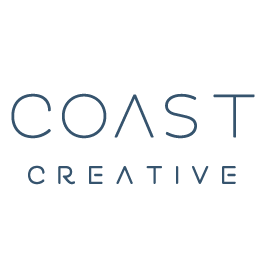Take a deep breath and just start!
When you’re building your business, it’s easy to get bogged down in the day-to-day stressors of making it work. Nevertheless, it’s vital that you take a step back and look at the whole picture—which should include a solid digital presence. Here at Coast Creative, most of what we do lives in the digital world, so we’ve created a pretty solid checklist for new clients. And that’s what we’re sharing today!
Your presence on the web could be the difference between customers pouring through your doors and having to shutter them for good. So take a deep breath and see how many of these line items you can check off.
Based on our experience, for small business owners in this day and age, we highly recommend you have:
- A High-Quality Website (user experience, copy + visuals, SEO)
- Google Analytics
- Google My Business Listing (for brick-and-mortar stores or if you travel to your customers)
- Cohesive Branding
- A Lead Capture Mechanism (Email Sign-up)
- A Social Media Presence (Build Your Community)
- High-Quality Visual Content
- Reputation Management
- IRL (In Real Life): Community events & Collaborations
Bonus: Ad Spend budget
Why Do I Need a Website?
A website is essentially your online store, a one-stop shop for all information about your business. If you don’t have a brick-and-mortar business, a website is even more necessary. You can make online sales, gather emails from interested customers and follow up with them later on, and write a blog that provides readers with quality information that can help them in their purchase decision-making process. There’s a lot more capabilities that come with having a website, in addition to providing a professional and authoritative online presence for your business.
What distinguishes a high-quality website?
To build a website that engages and excites your visitors, you need to think about the user experience, writing clear and concise copy, and including at least 15 to 20 unique, high resolution images specific to your brand/business (more on this later).
Breaking this down further, you should ask yourself:
- What action(s) do I want visitors to take?
- What should my tone be? Playful, authoritative, casual? What language represents my business and what doesn’t?
- What must anyone understand about my business when they visit my website?
- Is there a clear path to the end goal of having a visitor complete a purchase, sign-up for your newsletter, schedule a consultation or reach out for more information?
You should take the time to write out all the information you’d like to have included on the website. This should be done before design to help you understand how many pages you need, what information is most important and where you should place it, etc. And if you’re not a writer…don’t attempt to write all the final website copy yourself.
Being able to concisely and compellingly share your story and information about your products and/or services is HUGE.
Professional copywriters are great at what they do and trained to write persuasively using long-established copy techniques. If you know you’re not a writer, do some research and find someone who can help you reach that end-goal of launching your website with confidence.
Sometimes it’s difficult to understand what’s not as important. But knowing what is can help you establish hierarchy on your site, from header font sizes and capitalization to a clean minimal footer with only the essential business information included. Picture a funnel and think about building your pages that way to create a website that’s visually appealing, intuitive and not jarring to your site visitors.
“Read Now”
Distributing call-to-action buttons throughout the website is a great way to give visitors opportunities to complete actions that lead them toward becoming actively interested in your product or service, willing to exchange personal information (i.e. an email address) in exchange for downloadable content, and ultimately purchasing a product or getting in contact with you to use your services.
Tip: Never include different call-to-actions simultaneously next to each other on the page. If they are the same action, i.e. “Reserve Now” right next to each other, that’s ok. Don’t have your visitors choose between two actions–that leads to confusion and non-action.
Search Engine Optimization Steps to Consider
Add a Meta-Description To Each Page: This should be a short sentence using the same keyword as the title of the page you’re working on, but it should not say exactly the same thing as what’s in that page’s content.
One Keyword Per Page (except on your home page): Optimize your website by including keywords throughout your site content so search engines can “crawl” it, or read and understand the contents of your site more easily. This will help your site to rank when someone is using those keywords to search.
To learn more, read this blog post on optimizing the most critical parts of your website from one of our favorite marketing resources, HubSpot.
Tip: Try to have at least 500 words per page as it applies to ensure you are providing enough quality content for both users and search engines to understand. Don’t write just to write. Make sure your content is helpful and engaging, first and foremost.
Thinking about where to build your website? For more information on the difference between popular website design platforms Squarespace and WordPress, check out our blog post.
Don’t worry, we’ve got the rest of the list coming soon! Stay tuned and don’t forget to follow us on Instagram to get the latest.


